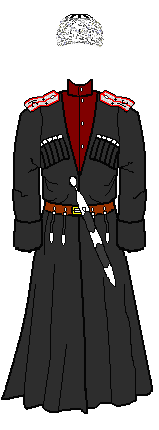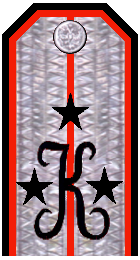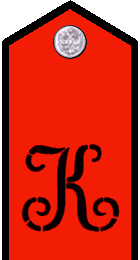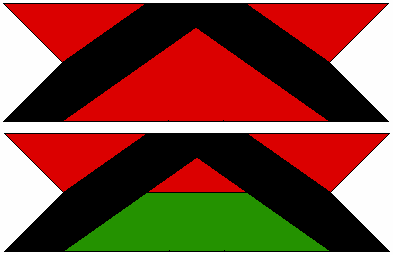
Kornilov Kuban Horse
Also known as the 1st Kuban Horse Regiment.
A slightly different unit of the Kuban Host, recruited from Kuban Cossacks, renamed in honour of General Kornilov.
Kornilov Horse Regiment
 |
 |
||
| Trooper | Pod-poruchik (2nd Lieutenant) |
The basic uniform started out as a standard Kuban outfit. It was modified with black trim in mid-1918, and in Spring 1919 the white hats were made formal issue.
Uniform Details
 |
 |
 |
 |
| Shoulderboards: Sotnik (Lieutenant) | Shoulderboards: Kazak (Trooper) | Original officer's hat, and extra "mourning" version | March 1919 hats: private, NCO and officer |
In August 1918 (or thereabouts) it was decided to honour Kornilov by adding black mourning markings to this unit. The usual Kuban red shoulderboards were edged in black. A black letter "K" (for Kornilov, not Kuban) was added and all ranks markings were changed to black. Officers braid was still silver.
The trouser stripe was also made black. Officially a sloping white stripe, silver for officers, was added to the front of the normal Kuban papakha (which could be any colour). Some officers took the black/red theme a bit further, and replaced the silver braid on their hat tops with black as well.
In March 1919 the uniform was revised. The shoulderboards remained as before with a red base, and with the letter K, piping around the outside, stars for officers and cotton strips for NCOs all in black. The black trouser stripes too remained. However the papakha changed to a small all-white version, with white top. NCOs had a cross of two stripes in black, whereas officers had four stripes.
The men attempted to get black cherkeskas and retained the usual Kuban red bashlyks to complete the red/black theme.
History in the RCW
Originally the Kuban Horse Divizion, formed during the Kuban Ice March, it had become the 1st Kuban Horse Regiment by the end of March 1918. It was formed from Cossacks from all over the Kuban, so had no Imperial tradition to fall back on. By June 1918 it was up to 510 sabres, with 4 MGs.
During the Second Kuban March the Volunteer Army gained another unit of the same name when it absorbed a local partisan group, so in August Colonel Naumenko asked that his version be renamed to honour the most famous name of the White cause. It fought that campaign as part of the 1st Horse Division.
In April 1919 it had only about 200 sabres, a small tachanka command and some attached artillery.
It fought with the Caucasian Army after this, taking heavy losses. In October 1919 it was part of the 3rd Kuban Cossack Division. Even after having several smaller units merged into it the regiment still numbered only 334 sabres and 21 MGs. It took even more losses during the retreat back the Kuban.
In April 1920, now part of the Kuban Army, the bulk of the unit surrendered to the Reds in Adler.
By July 1920 sufficient men had made it to the Crimea that it was reformed as a divizion and then a regiment in the 1st Kuban Division. It took part in the Kuban raid under General Ulagay.
During the last campaign into the Northern Tauridia, still part of the 1st Kuban Division, it numbered 300 men and 16 MGs.
Its commanders included some of the more famous names in the White cause: Colonel G. Ya. Kosinov (to May 1918), Colonel V. G. Naumenko (to August 1918), Lt-Colonel Colonel Ermoleno (to September 1918), Colonel Fedenko (killed September 1918), Lt-Colonel then Colonel N. G. Babiev (to January 1919), Captain then Lt-Colonel F. I. Eliseev (to June 1919), Colonel Golovin (to April 1920) and Lt-Colonel Bezladniy (April 1920). The reformed unit was commanded by Colonel Makeev during the Tauridia operation.
This unit bore no relationship with the famous Kornilov Infantry Regiment (later, Division). That unit grew to include some cavalry elements, but they were entirely separate and not Cossack.
Flags
In September Ataman Filimonov gave the newly named Kornilov Horse Regiment a regimental colour granted by Emperor Aleksandr I in 1803 to Black Sea Cossacks (most members of the unit were in fact recruited from Black Sea Cossacks). I can't see that flag being carried in battle though, since it was over 200 years old and would have been beyond fragile.
The battlefield regimental flag was:

There is a drawing, presumably from a member of the unit, showing it being at the front in a charge.
The usual Kuban sotnia guidons also gained a wide black "mourning" stripe. Below are those for the first and fourth sotnias (squadron colours being red, blue, white, green, yellow and brown in order).

All flags had black horse tails attached to the poles as well, in the ancient Cossack tradition.
Sources
F. I. Eliseev wrote quite a large book on this unit, With the Kornilov Horse.
The Kornilov Horse Regiment of the Kuban Cossack Host, by A. I. Deryabin, from Tseikhgauz issue 6. (This material is largely repeated in Deryabin's book on the Whites, and is mostly taken from Eliseev.)